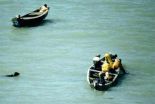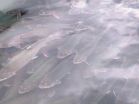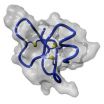(Press-News.org) Catalan researchers have studied the marine trophic network in Mauritania, on the north west coast of Africa, which is an extremely heavily exploited fishing area, as well as being home to two of the world's most threatened species of marine mammal – the monk seal and the Atlantic hump-backed dolphin. The results of the study show that industrial and traditional fishing activities along the coast are putting these mammals and local marine ecosystems at great danger.
The researchers studied the local marine trophic network off the north west coast of Africa, and by analysing stable carbon and nitrogen isotopes were able to verify the distribution and trophic position of 13 mammal species and also that of other species of macro seaweed, marine plants, fish, molluscs, turtles and phytoplankton, which had never been studied before.
The monk seal (Monachus monachus) and the Atlantic hump-backed dolphin (Sousa teuszii) are "the most coastal species of the whole area studied, and are the only ones occupying this marine ecosystem", Ana M. Pinela, lead author of the study and a researcher at the University of Barcelona (UB), tells SINC.
The Portuguese scientist says this area, which is so "extremely" over-exploited by both industrial and traditional fishing "should be a conservation priority for these species, which are important for biodiversity. If they disappear, it would be hard for others to take their place". This would cause a "serious" imbalance "at all levels" in local coastal ecosystems, which would remain without two super-predators that are "essential" for them to function properly.
The study, which has been published in Marine Ecology Progress Series, shows the importance of the predators Monachus monachus and Sousa teuszii for the proper functioning of coastal ecosystems in Mauritania.
The killer whale (Orcinus orca), which is also present in Mauritania, feeds at the same trophic level as the monk seal, meaning it feeds on fish, and not on marine mammals as it does off some other coasts. However, "its range is much more pelagic (of open oceans)", says Pinela, who has described the offshore ecotype of the killer whales in this region for the first time.
"Unprecedented" fishing exploitation
"Mauritania contains some of the most heavily-exploited fisheries habitats in the whole world, with one of the world's largest fisheries stocks, which is subject to very little regulation, inspection or control", explains the researcher. Two of the world's most threatened species live off this coast – the monk seal, which is on the verge of extinction, and the hump-backed dolphin, which has a very limited geographic range and is little known.
The scientists say conservation of these coastal areas should be "a priority". "The Mauritanian Government and international agencies should more strongly monitor both industrial and traditional fisheries exploitation both in deep sea and coastal areas", says Pinela. Over-fishing and the over-exploitation of resources limits the availability of prey for these species and damages ecosystems.
The research team is calling for "more diligent" regulation of such fishing practices, monitoring and control of the fishing fleet, "be it Mauritanian or international", and the implementation of sustainable fishing off the north west of Africa.
In addition, estimates should be made of fish abundance and catches in the entire study area, because it is "a biodiversity hotspot that is home to a great diversity of marine mammals", concludes Pinela.
INFORMATION:
References:
Pinela, A.M.; Borrell, A.; Cardona, L.; Aguilar, A. "Stable isotope analysis reveals habitat partitioning among marine mammals off the NW African coast and unique trophic niches for two globally threatened species" Marine Ecology-Progress Series 416: 295-306, 2010
Monk seal and hump-backed dolphin are threatened by fishing activities off coast of Mauritania
2011-01-22
ELSE PRESS RELEASES FROM THIS DATE:
Montrealers are feeding fish Prozac
2011-01-22
This press release is available in French.
Around one in four Montrealers take some kind of anti-depressant, and according to new research, the drugs are passing into the waterways and affecting fish. The findings are internationally significant as the city's sewage treatment system is similar to that in use in other major cities, and moreover, it is reputed to be the third largest treatment system in the world. Lead by Dr. Sébastien Sauvé at the University of Montreal's Department of Chemistry and André Lajeunesse, a PhD candidate, the research team found that the ...
New Anglo-Swiss research questions impact of GM wheat on insects
2011-01-22
An Anglo-Swiss research project has found that the impact of disease-resistant genetically-modified wheat plants on insects may be negligible.
Many studies have looked at the effects of genetically-modified (GM) plants on single non-target insects. However, agro-ecosystems are characterised by numerous insect species forming food webs. This study is the first to investigate different transgenic disease-resistant wheat lines and their effect on the structure of whole aphid-parasitoid food webs.
The findings are published this week in the Royal Society journal, Biology ...
Nanoworld in color
2011-01-22
This press release is available in German.
Lights off – projector on. Lecture theaters, conference halls and seminar rooms currently have to be darkened if the speaker wants to project a presentation on screen. Unfortunately, the attention of the listeners goes off with the lights, and tiredness takes over. A new technique promises to remedy this situation. The projectors of the futur will not only be small and easy to use but also shine so brightly that the images appear sharp and clear, even in a sun-filled room.
The image illuminating the wall of the Fraunhofer ...
Researchers reveal function of novel molecule that underlies human deafness
2011-01-22
New research from the University of Sheffield has revealed that the molecular mechanism underlying deafness is caused by a mutation of a specific microRNA called miR-96. The discovery could provide the basis for treating progressive hearing loss and deafness.
The research team, led by Dr Walter Marcotti, Royal Society University Research Fellow from the University's Department of Biomedical Science, in collaboration with Professor Karen Steel at the Sanger Institute in Cambridge, discovered that the mutation in miR-96 prevents development of the auditory sensory hair ...
New study of environmental contaminants in breast milk
2011-01-22
The levels of environmental contaminants in a mother's body decrease during breast-feeding. After a year of lactation, the levels of a number of environmental contaminants in breast milk drop by 15 – 94 per cent, according to a recent study from the Norwegian Institute of Public Health. There has been little study into this topic previously.
Breast milk is nutritionally the best food for infants and contains all the substances a child needs for optimal growth and development. However, breast milk contains low but measurable concentrations of environmental contaminants, ...
With cloud computing, the mathematics of evolution may get easier to learn
2011-01-22
BUFFALO, N.Y. -- An innovative, educational computing platform developed by University at Buffalo faculty members and hosted by the cloud (remote, high-capacity, scalable servers) is helping UB students understand parts of evolutionary biology on an entirely new level. Soon, high-school and middle-school students will benefit from the same tool as well.
Pop! World, developed by UB faculty members with a $250,000 National Science Foundation grant, takes advantage of cloud computing, which allows programs to run on remote servers instead of through departmental or institutional ...
New melt record for Greenland ice sheet
2011-01-22
New research shows that 2010 set new records for the melting of the Greenland Ice Sheet, expected to be a major contributor to projected sea level rises in coming decades.
"This past melt season was exceptional, with melting in some areas stretching up to 50 days longer than average," said Dr. Marco Tedesco, director of the Cryospheric Processes Laboratory at The City College of New York (CCNY – CUNY), who is leading a project studying variables that affect ice sheet melting.
"Melting in 2010 started exceptionally early at the end of April and ended quite late in mid- ...
Preventing tooth decay in the youngest American Indians
2011-01-22
INDIANAPOLIS – A study conducted in four American Indian communities in the Pacific Northwest presents an effective strategy to convince mothers to switch young children from drinking sweetened soda to water and shows that eliminating these sugary drinks from the diets of the youngest members of the tribe significantly decreased tooth decay.
The results of the dental arm of "The Toddler Overweight and Tooth Decay Prevention Study" (TOTS), which targeted American Indians from birth to 30 months of age, appear in the current issue (Volume 20, Number 4) of the peer reviewed ...
Mars Express close flybys of martian moon Phobos
2011-01-22
Mars Express has returned images from the Phobos flyby of 9 January 2011. Mars Express passed Mars' largest moon at a distance of 100km.
The HRSC-camera recorded images of Phobos on 9 January 2011 at a distance of 100 km with a
resolution of 8.1 m/pixel. Due to the stereo viewing geometry during the flyby a small part of
the moon’s edge is only visible for the right eye resulting in odd 3D-perception in this area.
This part has been slightly adjusted for better viewing. Also, for the left eye at the left
edge of the image four small data gaps have ...
Defense mechanism against bacteria and fungi deciphered
2011-01-22
Under standard laboratory conditions, the human beta-defensin 1 (hBD-1), a human antibiotic naturally produced in the body, had always shown only little activity against microbes. Nevertheless the human body produces it in remarkable quantities. The solution to the puzzle was the investigation process itself, as the research group led by Dr. Jan Wehkamp at the Dr. Margarete Fischer-Bosch Institute for Clinical Pharmacology of the Stuttgart-based Robert Bosch Hospital found out.
Before the research group took a new approach to this research, defensins were usually tested ...






